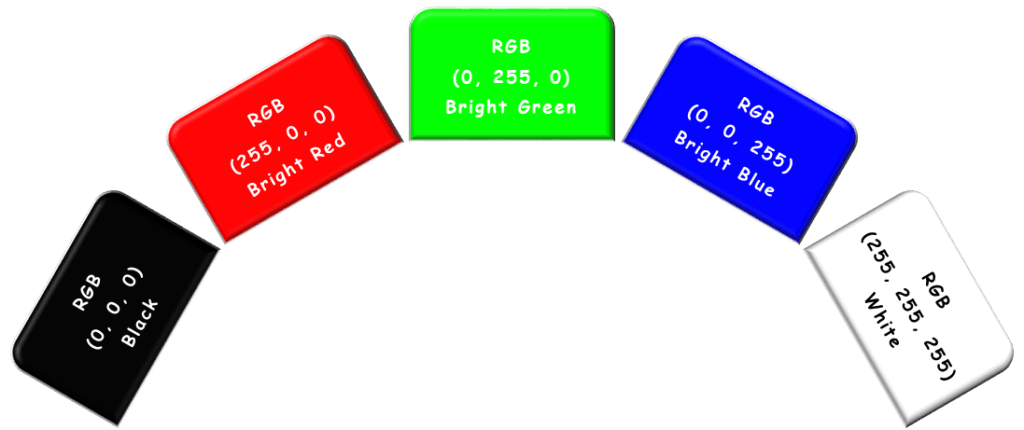This simple guide will let you know how to store 3 types of media files on a computer, including storing images, audio, and video in a computer.
Table of Contents
Introduction
Have you ever wondered how your smartphone saves a photo, records your voice, or streams an entire movie? Whether it is a selfie, a song, or a film, all forms of media on digital devices are ultimately stored as binary data—just sequences of 1s and 0s.
Here, you will explore how pixels, sound waves, and moving pictures are turned into digital files.
Understanding Data Sizes
All digital information is measured in bytes, and media files—especially images, songs, and videos—can be quite large. Here is a quick guide to how storage units scale:
| Unit | Equivalent |
| 1 Byte (B) | 8 bits |
| 1 Kilobyte (KB) | 1024 Bytes |
| 1 Megabyte (MB) | 1024 KB |
| 1 Gigabyte (GB) | 1024 MB |
| 1 Terabyte (TB) | 1024 GB |
| 1 Petabyte (PB) | 1024 TB |
| 1 Exabyte (EB) | 1024 PB |
| 1 Zettabyte (ZB) | 1024 EB |
| 1 Yottabyte (YB) | 1024 ZB |
Understanding these units helps you grasp why file size matters when saving or transmitting media.

Note that:
- An image file might have a size of 500 KB (Kilobytes).
- A music file might be around 5 MB (Megabytes).
- A full-length HD movie could be approximately 2 GB (Gigabytes).
- A large external hard drive could have a capacity of 1 TB (Terabytes).
1. What is an Image Digitally?
A digital image is made up of pixels.

A pixel (short for “picture element”) is the smallest controllable unit of a digital image or display. It is usually arranged in a rectangular grid and represents a single point of colour. Each colour of a pixel is stored using three components:
- Red
- Green
- Blue
These values range from 0 to 255 (28 = 256). By mixing these intensities, a computer can display millions of colours.
On screens, each pixel is made of sub-pixels (red, green, and blue elements). The combined light of these pixels creates the appearance of a single colour.
Example

Common Image File Formats
| Format | Full-Form | Features |
| JPEG | Joint Photographic Expert Group | Compressed to reduce file size (some quality lost) |
| PNG | Portable Network Graphics | Lossless compression and supports transparency |
| GIF | Graphics Interchange Format | Supports basic animation, limited colour palette |
How Are Images Stored?
To store an image digitally, the computer creates a grid of pixels. Each colour of the pixel is represented using RGB values. These values are stored as numbers in binary.
For example, a small 100×100 image has 10,000 pixels. If each pixel uses 3 bytes (1 for Red, 1 for Green, and 1 for Blue), the raw image takes up about 30,000 bytes (around 30 KB).
Lossy vs Lossless Compression | Space Saving
To save space, most images are compressed. This compression can be:
- Lossy, like in JPEG, where some details are discarded to reduce file size.
- Lossless, like in PNG, where image data is reduced without losing any quality.
Real-Life Example
When you upload a photo to a website, it is usually saved as a JPEG to save space and load faster. However, it comes at a cost i.e., some image quality may be sacrificed.
2. What is an Audio Digitally?
Sound in the real world is a continuous wave of pressure moving through air.
To store and process sound (audio) on a computer, it (sound waves) must be converted from its analogue form into digital data. This process is done through sampling and quantization.
i. Sampling
The computer measures the amplitude of the sound wave at regular time intervals.
- Amplitude
Amplitude refers to the height of the wave at a specific moment. It determines how loud the sound is at that point. Amplitude is based on the sampling rate.
- Sampling Rate
The number of samples taken per second is called the sampling rate.It is measured in units of frequency (Hertz – Hz).
| Sampling Rate | Common Use |
| 44.1 kHz | CD quality |
| 48 kHz | Standard for video |
| 96+ kHz | Used in professional audio |
Higher Sampling Rate = Better Quality
ii. Quantization
Each amplitude measurement is turned into a number, which is then stored in binary (0s and 1s). More bits per sample indicate a more accurate representation of sound.
Example
For example, for a CD-quality audio:
- Sampling rate: 44,100 times per second (44.1 kHz)
- Bit depth: 16 bits per sample
- Channels: 2 (stereo)
So,
1 second of CD-quality stereo audio = 44,100 samples × 16 bits × 2
1 second of CD-quality stereo audio = 1,411,200 bits
1 second of CD-quality stereo audio ≈ 176 KB
Common Audio File Formats
| Format | Full-Form | Description |
| MP3 | MPEG-1 Audio Layer III | Compressed; smaller file size, some quality lost, easy online sharing |
| WAV | Wave Audio File Format | Uncompressed, high quality, but large size |
| AAC | Advanced Audio Coding | Efficient compression with good sound quality; used in streaming |
How Audio Is Stored?
When sound is recorded:
- The analogue wave is sampled at regular intervals.
- Each sample is quantized into a number.
- These numbers are stored as binary.
- A collection of samples makes up a digital audio file.
Storage Formula
Audio File Size = Sampling Rate × Bit Depth × Channels × Duration
Here:
Sampling Rate = number of times per second the sound is sampled (e.g., 44,100 Hz)
Bit Depth = number of bits used to represent each sample (e.g., 16 bits)
Channels = number of audio tracks (e.g., 2 for stereo, 1 for mono)
Duration = length of the audio (in seconds)
Compression formats like MP3 reduce this size by removing sounds that humans are less likely to hear, balancing quality and file size.
Real-Life Example
A 3-minute song as an MP3 might be around 5 MB, while the same song as a WAV file could be 50 MB or more.
3. What is a Video Digitally?
A video is a sequence of images shown one after another, along with synchronised audio. These images are termed as frames, and the smoothness and quality of the video depend on the frame rate.
Frame Rate
The frame rate, measured in frames per second (fps), indicates how many pictures are shown every second. The common frame rates (fps) and their common uses are listed here.
| Frame Rate | Common Use |
| 24 fps | Standard for films |
| 30 fps | Typical for TV broadcasts |
| 60+ fps | Used in games and high-frame-rate video |
More frames per second = smoother motion.
Example
Imagine a flipbook: the faster you flip the pages (higher fps), the smoother the animation looks.
Common Video File Formats
| Format | Full-Form | Features |
| MP4 | MPEG-4 | Compressed, high-quality, widely supported |
| AVI | Audio Video Interleave | Older format: large files, less efficient |
| MKV | Matroska | Supports multiple audio/subtitle tracks; good for high-quality storage |
How is Video Stored?
Nowadays, video creation has become a popular hobby. These videos are commonly created for sharing on online platforms, especially short-form content.
Frame-Based Structure
Each frame in a video is similar to a still image. When played in rapid sequence, they create the illusion of motion. However, storing every frame as a full image would require a large amount of data. This is where the video compression comes into play.
Video Compression
To reduce file size and make storage and streaming more efficient, videos use compression techniques, such as:
i. Inter-frame compression
Instead of saving each frame entirely, only the changes between frames are stored. For example, if a person moves while the background stays the same, only the moving parts are recorded.
ii. Compression algorithms
Formats like MP4 use advanced algorithms to remove repetitive data and reduce file size without significantly affecting quality.
Audio Compression
The audio track is compressed separately using its methods (like AAC or MP3 codecs) to maintain quality while minimising file size.
Container Formats
Finally, the compressed video and audio streams are combined into a container format (such as MP4, MKV, or AVI). These containers hold:
- Video stream
- Audio stream
- Subtitles
- Metadata (e.g., resolution, duration)
Real-Life Example
Streaming services like YouTube and Netflix adjust video quality in real time based on your internet speed, balancing video resolution and frame rate to avoid buffering.
How Are Files Stored?
As you have seen, there are various media types: image, audio, or video. Regardless of the media type, all files are stored as binary code. These 1s and 0s can be saved on physical and/or cloud-based storage systems.
Types of Storage Devices
| Device | Features |
| HDD (Hard Disk Drive) | Mechanical parts, large capacity, slower speeds |
| SSD (Solid State Drive) | Faster, more durable, no moving parts |
| Cloud Storage | Accessible online from any internet-enabled device |
The first hard drive, developed by IBM in 1956, could store just 5 MB of data and weighed over 1,000 kg!
Conclusion
All digital media relies on smart encoding and efficient storage. Whether it is a pixel, a sound wave, or a frame in a video, computers break down everything into binary, compress it, and store it for instant access.
Thanks to advances in compression and storage technology, you can now carry thousands of media files in your pockets – something that was unthinkable just a few decades ago.
Frequently Asked Questions (FAQs)
What do you know about 3 types of media files ?
Predominently, there are 3 types of media files – images, audios, and videos.
What do you know about storing images, audio, and video in a computer?
They are stored as digital files using formats like JPEG/PNG (images), MP3/WAV (audio), and MP4/AVI (video), made up of binary data.
What are the tiny dots that make up an image called?
Pixels
In an RGB colour model, what does RGB stand for?
Red, Green, Blue
What is a file format?
A file format is a standardised way information for storage in a computer file. Different media types (images, audio, and video) use different formats.
What is the resolution of an image?
Resolution refers to the amount of detail an image holds, typically measured in pixels (e.g., 1920×1080).
How is audio stored digitally?
Audio is stored as a series of binary numbers that represent sound waves. Common formats include MP3, WAV, and AAC.
What does compression mean in media files?
Compression reduces the file size of images, audio, or video by removing redundant or less important data, which can be either lossless or lossy.
What is the difference between lossy and lossless formats?
Lossy formats (like JPEG or MP3) reduce file size by removing some data permanently. Lossless formats (like PNG or FLAC) retain all original data.
How is video stored on a computer?
Video is stored as a series of images (frames) combined with audio, encoded into formats like MP4, AVI, or MOV.
What does frame rate mean in a video?
Frame rate is the number of individual frames shown per second in a video. It is measured in frames per second (fps), e.g., 30 fps.

